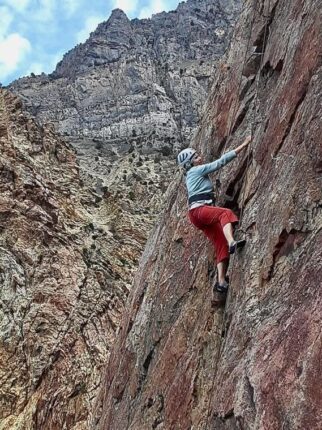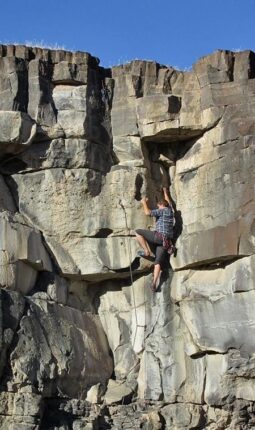On our last day of a three-day climbing trip, my sweetheart Julie was happy to proclaim, “I climbed my three routes today without hanging (on the rope).”
As a group, we decided to mix things up.
Last week my sweetheart and I were joined by my youngest son Sam and his wife in Lander, Wyoming, for three days of rock climbing during the International Climbers’ Festival. Later, we were joined by more friends.
In the Lander area, there are several amazing dolomite limestone cliff bands that attract rock climbers from around the country and even internationally. It’s one of my all-time favorite places to climb. There are about a thousand bolted routes in the area.
In years past we traditionally fell into a pattern of tried and true walls to focus on. We returned to the same walls and routes year after year, like an ingrained migration pattern. This year we deliberately changed directions. Why not? Even though we’d been to the area for about 20 years, there were still several places we hadn’t climbed and some new walls had been added to the list. Local route developers are still busy adding new routes and new walls to the list of dozens of walls in the area.
So, we bought an updated guidebook (2018) and launched off into the unknown.
Our first day we climbed at the OK Corral at Wild Iris on the edges of the Wind River Mountain Range. We’d been to the OK Corral before, but we were looking for unfamiliar routes. Many of the names and places in the area pick Western themes often with cowboy flavors because of the local ranching tradition. (The T-shirt they gave out for the festival had the image of a woman climbing a rock wearing a Stetson and cowboy boots.)
Sam had a new, unused rope that he wanted to christen on a noteworthy route. His first climb of the day was called Poker Face Alice (a long-standing standard test piece we had never tried). Unfortunately, it was not a warmup route — rated a difficult 5.12 — for experts only. The first half was easy, then the climb went under a horizontal bulge. Sam and I both gave it a whirl with predictable results. It was like being spanked with a buggy whip. Our arms and hands felt like they’d been stepped on by an Angus bull. But it was still fun taking giant falls out into space.
Another area we had usually passed over at the OK Corral was the Tribal War wall. One of my favorite climbs of the trip was at this wall — a challenging moderate route with plenty of pockets in the rock to keep it doable.
The next day we went to Sinks Canyon and instead of hiking up to the north side of the canyon like we have in years past, we headed to the shady south side, reputed to have shade all morning until 3 p.m. Despite the four-day festival bringing hundreds of rock climbers to the area, we shared the entire wall with two other climbers till it was nearly quitting time.
With our new climbing guidebook, we were a bit confused as to which route was which at this wall. Apparently, some new routes were added to the wall since the book was published. Guidebooks are always trying to hit a moving target. There were plenty of routes to keep our group of seven with four ropes busy until the sun finally started to blast the wall.
Lander is great for dirt-baggers. You can camp for free in the city park for three days (there are lots of grass and mature trees similar to Tautphaus Park in Idaho Falls). There’s also free camping at Wild Iris, which can be cooler because of its 8,000-foot elevation.
Sinks Canyon is about a 10- to 15-minute drive outside of Lander with another 15 to 30 minutes of hiking depending on the wall you’re heading to. Wild Iris is a 30- to 45-minute drive south of town with anywhere from 5 to 25 minutes of hiking depending on the wall you’re going to. There are several other developed areas near Lander that add up to a lifetime of climbing and hiking possibilities. Lander is about a 4.5-hour drive from Idaho Falls.
When your hands and arms get worn out from climbing, there’s always backpacking into the nearby world-class Wind River Range.
Jerry Painter is a longtime East Idaho journalist and outdoorsman.


